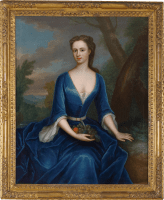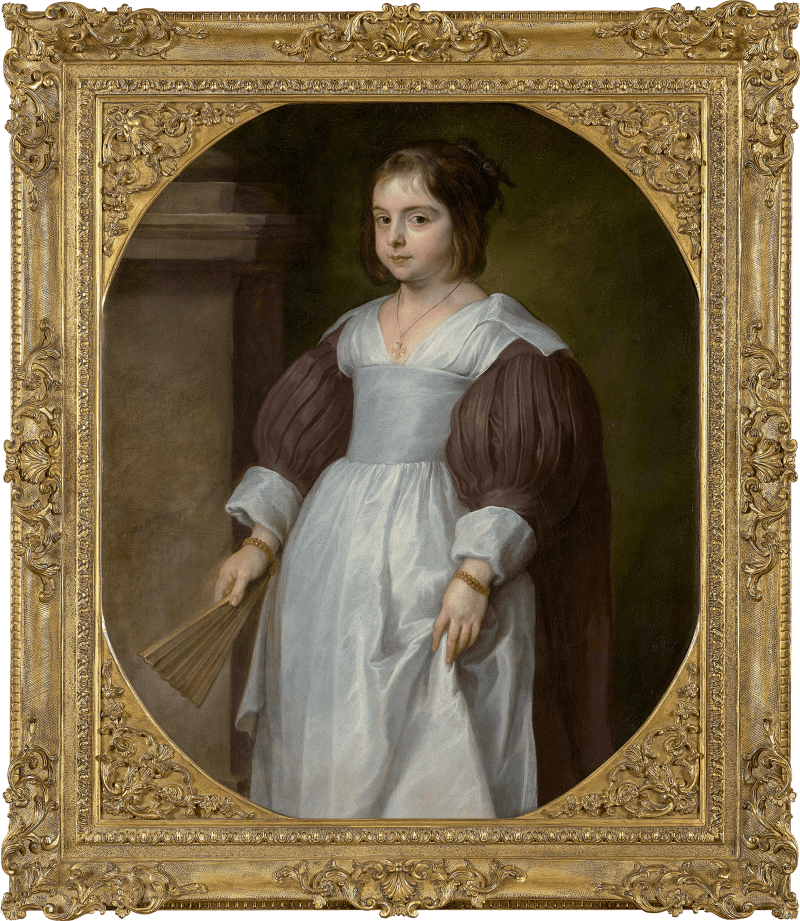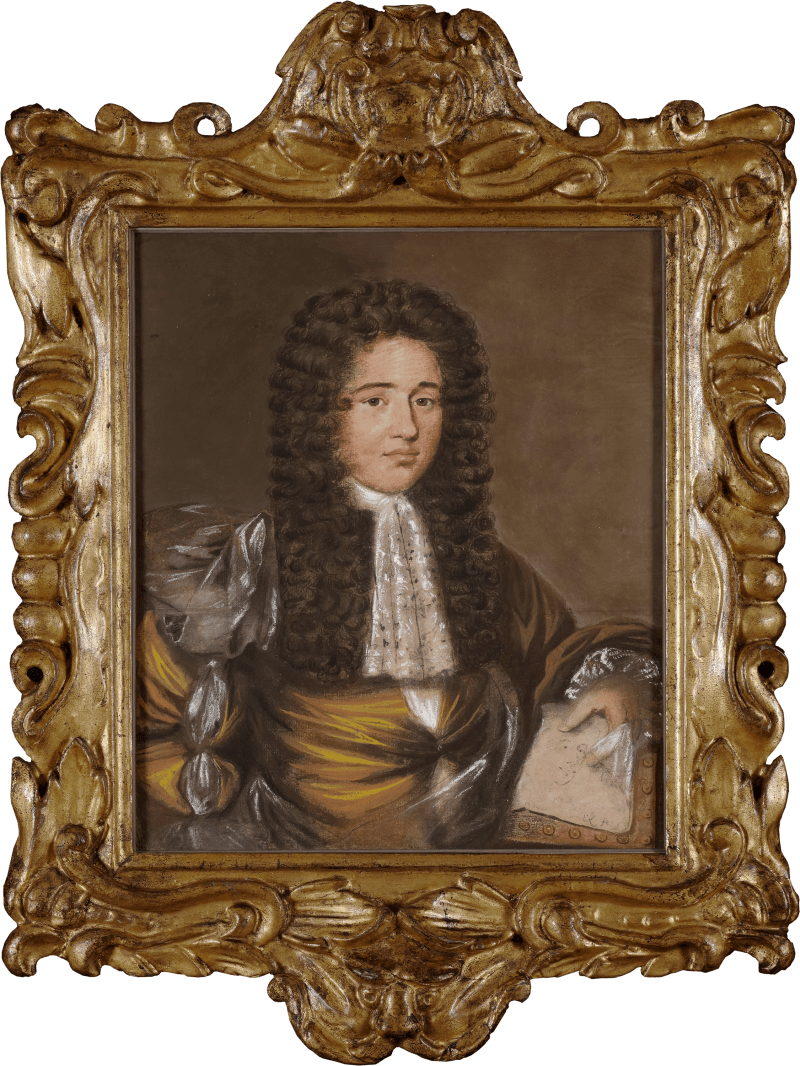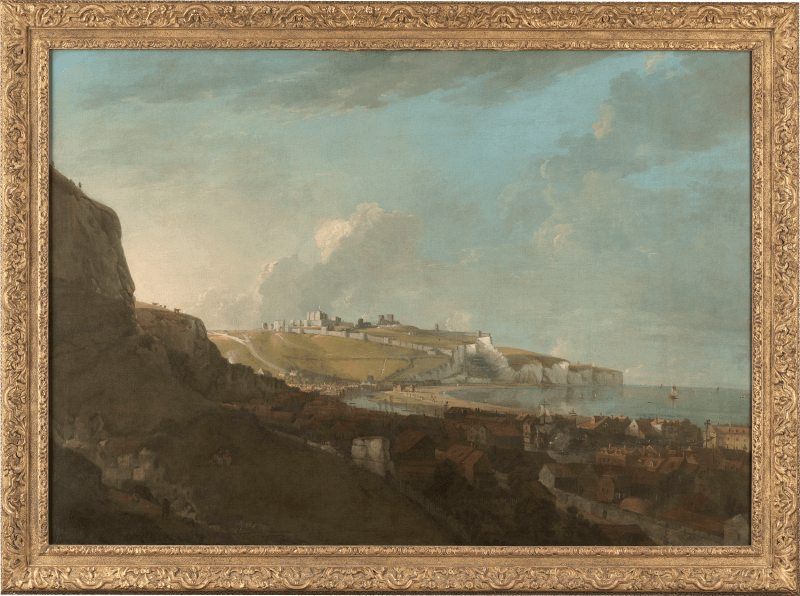This refined portrait, recently reattributed to Adriana Verelst, showcases the skill of one of early eighteenth-century England’s most accomplished women artists. The pairing of artist and sitter offers an insight into the lives of two pioneering women who individually overcame gender biases to achieve remarkable success in their personal and professional lives.
The Verelst family was a remarkable dynasty of Dutch painters, spanning generations and excelling in portraiture and history painting across Europe. Adriana Verelst’s identity has only recently been clarified; for centuries, she was misidentified as ‘Maria’. Recent research by Peter Hancox has significantly enhanced our understanding of her true identity and career within the family’s artistic network.[1] Biographical details remain fragmentary, contributing to longstanding confusion over her name. She likely received her early artistic training within the studios of her father, Herman Verelst, and her uncle, Simon Verelst. Her portraits are immediately recognisable for recurring compositional motifs, notably the inclusion of the luxurious blue dress cinched with a...
This refined portrait, recently reattributed to Adriana Verelst, showcases the skill of one of early eighteenth-century England’s most accomplished women artists. The pairing of artist and sitter offers an insight into the lives of two pioneering women who individually overcame gender biases to achieve remarkable success in their personal and professional lives.
The Verelst family was a remarkable dynasty of Dutch painters, spanning generations and excelling in portraiture and history painting across Europe. Adriana Verelst’s identity has only recently been clarified; for centuries, she was misidentified as ‘Maria’. Recent research by Peter Hancox has significantly enhanced our understanding of her true identity and career within the family’s artistic network.[1] Biographical details remain fragmentary, contributing to longstanding confusion over her name. She likely received her early artistic training within the studios of her father, Herman Verelst, and her uncle, Simon Verelst. Her portraits are immediately recognisable for recurring compositional motifs, notably the inclusion of the luxurious blue dress cinched with a silver belt, as seen in the present portrait. She frequently situated her sitters within abundant natural landscapes, demonstrating careful attention to botanical and topographical. Here, the sitter’s relaxed yet poised posture, set against a gently receding landscape, exemplifies Verelst’s skill in integrating figure and environment.
Of Verelst’s extant works, very few are signed, yet contemporaneous accounts consistently praise her precise technique and the expressive quality of her portraits.[2] Significantly, Verelst was the first woman in England to incorporate full-length portraiture as a consistent element of her practice, aligning her work with the grander scale and ambition of contemporary male portraitists.[3] Her known oeuvre reflects the broader cultural and artistic currents of early eighteenth-century England, where Dutch émigré painters played a pivotal role in shaping taste and technique.
The likely sitter, Cassandra, was the daughter of the notable ornithologist Sir Francis Willoughby (1619-1672) and his wife Emma Barnard (1644-1725) and enjoyed a privileged upbringing. Her father was descended from two old established families, both named Willoughby, with estates in Lincolnshire, Warwickshire, and Nottinghamshire. By the time Cassandra was born, however, the family’s wealth and influence had been greatly diminished, and their grand family seat, Wollaton Hall, lay unoccupied since a fire ravaged part of the building in 1641.
Instead of occupying the palatial Wollaton Hall, built by her great-great-grandfather Sir Francis Willoughby, the family lived in the more modest Middleton Hall nearby. The family was dealt a further blow in 1672 when Cassandra’s father, to whom the family was devoted, died. In recognition of Sir Francis Willoughby’s significant scientific contributions and status, a baronetcy was created for Cassandra's eldest brother. Their mother remarried Sir Josiah Child (1630-1699) – far sooner than the children would have preferred – and there were immediate frictions. Cassandra's new stepfather significantly strained family relations when he took control of the Willoughby estate and began extracting substantial funds for personal gain. His actions sparked heated accusations from Cassandra’s brothers, who claimed that Child was exploiting their inheritance. This perceived injustice caused lasting familial discord. In 1687, deeply dissatisfied with their stepfather’s handling of their financial affairs, Cassandra (aged seventeenth) moved with her brother Francis (aged nineteen) to Willoughby Hall. Sadly, Francis died the following year, in September 1688. After his death, Cassandra took on his significant responsibilities, alongside her younger brother Thomas, who inherited the baronetcy.[4]
Cassandra’s extensive responsibilities at Wollaton Hall included overseeing repairs and renovations to the house and gardens, managing household affairs, and organizing the family’s extensive collections. Perhaps most remarkably, Cassandra documented her efforts in immense detail, revealing her deep involvement in decision-making processes typically reserved for men:
“There were also fine collections of valuable meddals, and other rarities which my father collected together of dryed birds, fish, insects, shells, seeds, minerals and plants and other rarities … All these were removed, and when we had them at Wollaton it was a vast business for us to clean, label and put them in order…”[5]
Cassandra’s willingness to join her brothers at Wollaton Hall, alongside her seeming indifference to marriage, opened up a world of intellectual pursuits that were otherwise closed to women. Amongst Cassandra’s greatest scholarly feats is her comprehensive two-volume family history, which she constructed – having taught herself to read medieval and Tudor script – from documents she found in the family archives. Alice Friedman writes ‘Cassandra’s peculiar status as the young mistress of her brother’s household at Wollaton gave her the opportunity to furnish and decorate a major country house at a very young age and left her the time not only for needlework and ordinary household duties but also to read, to write letters, to catalogue her father’s collection, to entertain friends, and to visit other country houses throughout England.’[6]
Travel became an essential aspect of Cassandra’s lifestyle. In March 1695 Cassandra and her brother Thomas began a series of journeys across England and Wales, which she meticulously recorded in her Account of the journeys I have taken & where I have been since March 1695. Her notebooks reflect a wide-ranging curiosity and analytical mind, with detailed descriptions of country houses, industrial processes, and natural curiosities. Cassandra’s travels were not just recreational; they were intellectual expeditions that allowed her to engage with the latest developments in architecture and landscape design. Written from the perspective of an early-modern woman, the rarity of Cassandra’s travel writings cannot be overstated; very few travel records by women survive from this date, likely due to the societal constraints that prevented women from journeying much further than their own, or husband’s, birthplace.
In 1713, at the age of 43, Cassandra married James Brydges, who later became the Duke of Chandos in 1719. It was around the time of her marriage that the present work was likely painted. The marriage marked a significant shift in her life, as she moved to Cannons, an estate in Edgware, Middlesex, which Brydges had acquired. This estate soon became the couple's primary residence, and they embarked on extensive renovations and expansions. In addition to her new roles as a wife and stepmother to Brydges two children – John and Henry - Cassandra’s previous experience in estate management saw her active involvement in the renovation of Canonns, aided by her knowledge of country houses and gardens gleaned during her earlier travels. Numerous paintings by Cassandra are also recorded in the inventory of Cannons, and Brydges’ House in St James Square, London. [7] Her painterly skills were commended by the likes of Horace Walpole, who, after a visit to Cannons almost ten years after Cassandra’s death, stated: ‘His [the duke’s] late lady was a great painter’.[8]
A number of portraits by Verelst are listed in the 1725 inventory of Cannons and 9-11 St James’ Square and the Chandos collection contained at least thirteen paintings by her.[9] At Cannons, ‘Duke of Chandos ½ length by Mrs Verlest £20’ and ‘Duke and Duchess of Chandos by Mrs Verlest £30’ were listed, and at 9-11 St James’ Square, ‘The Duchess of Chandos whole length by Mrs Verelst £35’, ‘Lady Chandos Do by Mrs Verelst £35’.[10]
Verelst and Cassandra had much in common; both polymaths, both inspired by intellectual pursuits, and both painters, albeit of differing degrees of professional notoriety. Verelst’s depiction of Cassandra exemplifies the artist’s distinctive working method and compositional preferences; Cassandra’s pose is typical of Verelst’s portraits of women, as is her blue dress with a sinched in belt and plunging neckline. Cassandra holds an assortment of fruit in her right hand, whilst her left is elegantly placed to her left, connecting her with the verdant surroundings.
In bringing this remarkable portrait to light, we are reminded not only of Adriana Verelst's artistic legacy but also of Cassandra Willoughby’s enduring intellectual and personal achievements. This painting stands as a testament to the resilience and pioneering spirit of two exceptional women who defied societal limitations to leave their indelible marks on history.
[1] Peter Hancox, (2024), 'The multigenerational and cross-national artist family Verelst (c. 1618-1752): The myth of Cornelius and Maria', Oud Holland. vol. 137, no. 4, pp.188-189.
[2] Peter Hancox, (2024), 'The multigenerational and cross-national artist family Verelst (c. 1618-1752): The myth of Cornelius and Maria', Oud Holland. vol. 137, no. 4, pp.188-189.
[3] Tabitha Barber, (2024) Now You See Us: Women Artists in Britian 1529-1920. London: Tate, p.44-47.
[4] Elizabeth Hagglund, (2001) ‘Cassandra Willoughby’s visits to country houses’, The Georgian Group Journal. vol. XI, pp. 185-202.
[5] Cassandra Willougby, (1702) The Account of the Willughby’s of Wollaton taken out of the Pedigree, old Letters, and old Books of Accounts in my Brother Sir Thomas Willoughby’s study. [University of Nottingham, Hallward Library, Department of Manuscripts and Special Collections, Middleton MSS].
[6] Alice T. Friedman, (1989) House and Household in Elizabethan England: Wollaton Hall and the Willoughby Family. Chicago: University of Chicago Press, p. 163.
[7] HEH, ST 83, Inventory of Cannons, 19 June 1725; HEH, ST 83, Inventory of St. James’s Square, 1725.
[8] Horace Walpole, Walpole’s Correspondence, vol. 30 (Oxford, 1961), 61.
[9] Tabitha Barber, (ed.) Now You See Us: Women Artists in Britian 1520-1920. London: Tate Publishing, 2024, p.44.
[10] Susan Jenkins, (2005) ‘‘An Inventory of his Grace the Duke of Chandos’s Seat att Cannons Taken June 19th 1725’ by John Gilbert’, in The Walpole Society. No. LXVII, pp. 93-192.











